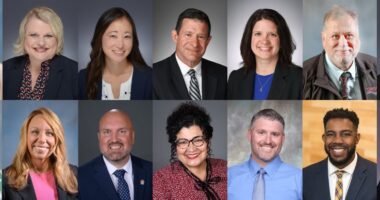4 Practical Strategies to Make Transformational Change
As a principal, there is no greater calling than to pour into those you serve to ensure successful change is built upon strong systems, aligned instruction, and a student-centered culture.

In May 1992, I received my first administrative assignment as a middle school principal. In my excitement, I contacted my mother, a public school teacher of over 30 years. The conversation transitioned from congratulatory to cautionary. In all her wisdom, as the outstanding educator she was, my educational hero made sure I understood that my success depended on how I treated and loved my staff. Specifically, she said, “Treat your secretaries and custodians with respect, always acknowledging their contributions.”
As I reflect on this interaction, I am reminded of many other experiential-based lessons I have learned along my administrative journey. I call these experiences “practical lessons from the field.” “The field” included the opportunity, as a principal, to lead turnaround efforts in both a middle school and a high school. Both schools were struggling due to changing demographics, low staff morale because of ineffective leadership, and student behavioral issues often associated with high-poverty urban schools. My tenure at both schools proved to be the most challenging, yet most rewarding, of my entire career.
Experiential-based lessons have a significant effect, shaping a passion that serves as the guiding principle for our leadership identity—the moral compass of why, who, and what we are as leaders. I have developed four key lessons that facilitated and supported my growth in developing a moral compass and heart connection to fuel my passion for the work.
1. Build Trust with Action and Follow-Through
Teachers, students, and parents care very little about what principals say and think; they want to see authentic listening and subsequent timely action. The spring prior to assuming the high school principalship, I planted myself in the library after school and met with anyone who wanted to answer two questions: “What is your vision for this school?” and “What immediate actions are needed to get us there?” To say I was surprised at the responses is an understatement. This school, based on data, was considered one of the lowest-achieving in the state.
In addition, student disruptions and gang issues were eroding the culture. The overwhelming responses from the students were that the bathrooms are dirty. Teachers did not like having to bring their own paper to the machines since it caused people to hoard and fight over the paper left in the machine. Parents wanted better two-way communication from the school.
What I gained from these listening sessions was a list of “low-hanging fruit.” These were items I could quickly act upon. As a result, as Stephen Covey mentions in The Speed of Trust, I could make timely deposits in the bank of trust knowing that I would need to make withdrawals as we enacted changes that would require greater human capital. We purchased paper and left it in the lounge for teachers to use; we monitored and kept the bathrooms clean; and we provided parents with monthly newsletters and initiated a parent advisory team. These simple actions were foundational in building a culture of trust which absolutely must exist to enact transformational change.
2. Be the Encourager, Not the Ego
“I am giving you the opportunity to make a difference in the ability of this middle school to be vibrant and full of educational possibilities for the students who need it the most.” These were the words of the superintendent when I began my principal journey at a middle school in crisis. He used similar words three years later when transferring me to a high school in crisis.
Leadership challenges such as these are both exciting and scary, and the tendency is to focus on one’s legacy in terms of success or failure. The resulting lesson from such a focus is to resist making it about you. An ego is not necessarily always about self-importance; with many well-meaning principals, it becomes a false narrative of self-reliance. I remember my first meeting with the high school leadership team. My recent middle school triumph had me brimming with confidence and clear plans for the future.
Yes, you know what is coming. I found a group of passionate leaders who had experienced years of being let down by an educational system that favored leadership cronyism over the genuine needs of urban students, and they were not open to another façade complete with educational jargon. Their passion was evident in their commitment and talent. Their perseverance through years of frustration needed to be nurtured and empowered rather than merely acknowledged. The relationship, which grew from mutual respect with this leadership team, forged a powerful foundation, resulting in outstanding success over the next three years. As the leader, I experienced the stress inherent to the work.
The goal here is not to minimize the impact of the principalship. In contrast, the lesson is to maximize a collective impact as you partner with and empower your staff to own the strategies, results, and struggles.
3. Balance Expectations, Humanity, and Systems
During my master’s program and practicum, I spent a year as an intern at the high school where I served as a science and physical education teacher. One of my duties was to substitute for assistant principals when meetings took them out of the building.
My very first discipline referral arrived one morning, involving a student who had taken all the mice from the science lab to prevent them being fed to the snakes. Really? What was I supposed to do with this? I scanned the “discipline code” and found no behavior code or subsequent punishment.
In addition, this student was not frequently in trouble and was very articulate about her passion in preventing animal cruelty. This first disciplinary interaction, and many more along the way, formulated an alignment between my belief about students and how adults should interact with students. The goal is always to help students learn from their mistakes with consequences rather than break their spirits with retribution and punishment.
When schools are in crisis, well-meaning adults often believe structured discipline, where each action has a subsequent consequence, is the best strategy for change. Nothing is further from the truth. Such discipline plans fail to address the humanity of each individual student, and the broken systems within the school, which are contributing to both adult and student behavior. In both turnaround opportunities, the biggest gaps resulted in failed systems. Positive cultures begin with high expectations, for both students and adults, and from this foundation robust systems are built, which enable a balance between determining collective accountability and building relational capacity.
4. Filter, Simplify, and Connect Professional Learning
In my fourth year as an assistant principal, my supervisor asked me to lead the introduction of the “district initiative of the year” during the August in-service. Excited by the opportunity, I begin preparing the training. In my naivete, the fact I was being set up completely went right over my head. Reality presented itself when, at the end of the training session, a veteran teacher raised her hand. I was hoping she was ready to proclaim that this was absolutely the best presentation of the new district initiative ever! Instead, she said, “Attention my fellow teachers, this too shall pass.” I was mortified and quickly shifted my emotions to blame teachers.
Further reflection from this experience and other professional learning opportunities helped me understand how the system of professional learning has created the monster of teacher disengagement; we tend to fail to filter, simplify, and connect our adult learning to really anything. The balancing act between district and building priorities can lead to a dizzying array of lists and strategies for teachers to digest and implement, which leads to an educational callousness, which mitigates any efforts to improve instruction.
As the building leader, I learned a key to success was creating an anchor of non-negotiable goals. Non-negotiables led to building-based and data-driven instructional priorities, which enabled me to filter all district and community initiatives and decide which ones to present to the staff. When presenting the initiatives, I simplified by eliminating baseless information and focused on applicable strategies. The strategies chosen directly connected to the building priorities.
A key lesson in this process was determining when to involve the building leadership team. Through trial and many errors, I learned to involve leadership in the simplify stage of the process. As the principal, it is imperative to find the sweet spot between involving your staff and overwhelming your staff.
Michael Fullan, in his book The Principal 2.0 said, “Put sharply, your job as a leader is to work with others to bring about desirable change while enabling the leadership skills of others who can carry on perhaps better than you after you depart.” As a principal, there is no greater calling than to pour into those you serve to ensure successful change is built upon strong systems, aligned instruction, and a student-centered culture. The ability to achieve such a calling is one of most difficult, yet rewarding, challenges within the landscape of public education.
Denise Wren is a retired administrator in Wichita Public Schools and the CEO of LeadershipFirst LLC.




